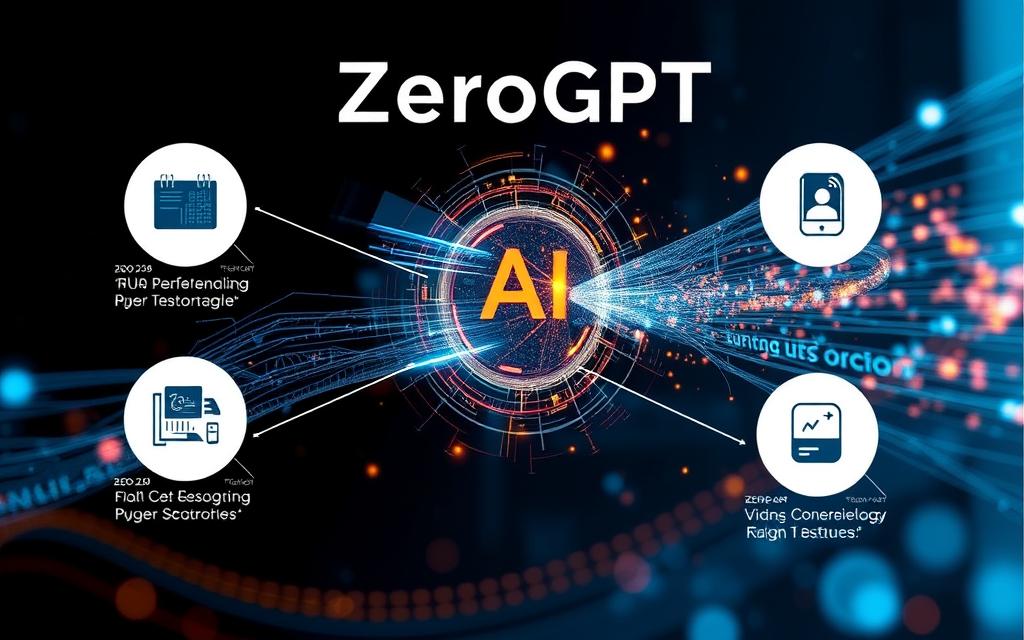Table of Contents
In today’s digital landscape, distinguishing between human and machine-generated content has become increasingly challenging. As a result, verifying the authenticity and accuracy of content has become crucial across various platforms and industries.
The growing importance of content detection technology has led to the development of sophisticated AI checkers. These tools serve as essential solutions for organizations, educational institutions, and content creators to maintain content integrity.
With the evolution of AI detection technology, leading solutions have emerged to offer reliable detection capabilities for identifying AI-generated content. Understanding the role of these tools is vital in today’s digital world.
The Rising Need for AI Content Detection
The increasing sophistication of AI-generated content has sparked a growing need for effective detection methods. Many prominent companies, including JPMorgan Chase, Northrup Grumman, Apple, Verizon, Spotify, and Accenture, have entirely blocked internal ChatGPT use due to privacy and security concerns, as reported by AI content detector Originality.AI.
The Proliferation of AI-Generated Content
AI-generated content is becoming increasingly prevalent, with language models capable of mimicking human writing patterns. This has led to a surge in AI-generated text across various industries.
Challenges in Distinguishing Human vs. AI Writing
Distinguishing between human and AI-generated writing is becoming increasingly challenging. Some of the key difficulties include:
- Analyzing the technical challenges in differentiating between human and AI-generated writing.
- Understanding how AI writing has evolved to incorporate human-like inconsistencies and stylistic elements.
- Recognizing the limitations of traditional plagiarism detection methods when applied to AI-generated content.
The need for a reliabledetectoris becoming more pressing as AI-generatedtextcontinues to evolve.
As AI-generated content becomes more sophisticated, it is essential to develop effective detection methods to maintain content authenticity standards. The challenges in distinguishing human writing from AI-generated writing highlight the need for advanced AI content detection tools.
Understanding AI Checker Technology
Understanding the mechanics behind AI checkers is crucial for evaluating their effectiveness. AI checkers are designed to identify content generated by artificial intelligence, but their accuracy can vary based on several factors.
How AI Detectors Work
AI detectors analyze content using complex algorithms to distinguish between human-written and AI-generated text. These detectors are trained on vast datasets to recognize patterns characteristic of AI-generated content. For instance, a study on detecting ChatGPT content highlights the challenges in identifying AI-generated text that has been paraphrased or “humanized.”
Detection Accuracy and Limitations
The accuracy of AI detection tools is not uniform and can be influenced by the type of content, language, and subject matter. While AI detectors have made significant progress, they are not infallible. Issues such as false positives, where human-written content is misidentified as AI-generated, can occur. Key considerations include:
- Analyzing the current accuracy rates of leading AI detection tools and factors influencing their reliability.
- Understanding the challenge of false positives, particularly for technical or non-native English content.
- Examining the occurrence of false negatives, especially when AI-generated content is edited or paraphrased.
- Considering how detection accuracy varies across languages, subject matters, and content types.
- Recognizing the importance of human oversight to ensure the results are correct and understanding the limitations of AI checkers.
ZeroGPT: Advanced AI Content Detection

ZeroGPT is revolutionizing the field of AI content detection with its advanced technology. Its AI detection model includes several components that analyze text to determine its origin and whether it was written by AI.
Key Features and Capabilities
ZeroGPT’s detection capabilities are powered by its proprietary DeepAnalyse™ Technology. This multi-stage methodology is designed to optimize accuracy while minimizing false positives and negatives. The technology analyzes content at both macro and micro levels, examining everything from overall text patterns to sentence-level linguistic markers that indicate AI generation.
DeepAnalyse™ Technology Explained
The DeepAnalyse™ Technology works by employing a comprehensive deep learning methodology, trained on extensive text collections from the internet, educational datasets, and proprietary synthetic AI datasets produced using various language models. This enables ZeroGPT to specialize in identifying AI-generated content from specific models like ChatGPT, GPT-3, GPT-4, Gemini, and LLaMa, ensuring comprehensive coverage of the AI generation landscape.
Originality.ai: Most Accurate AI Detector

Originality.ai has established itself as a premier AI detector, backed by rigorous research and development. Its advanced technology is designed to verify the authenticity of digital content with high accuracy.
Research-Backed Detection Accuracy
Originality.ai’s detection capabilities are supported by comprehensive research, ensuring a high level of accuracy in identifying AI-generated content. This research-backed approach makes it a reliable checker for maintaining content integrity.
Complete QA/QC Solution
Beyond AI detection, Originality.ai offers a complete suite of QA/QC tools, including Plagiarism Checking, Fact Checking, and Readability Checking. This comprehensive solution enables content teams to streamline their editorial process, ensuring that content is not only authentic but also of high quality and optimized for search engines.
The platform’s integrated approach allows for multiple quality checks within a single workflow, making it an invaluable resource for content creators and editors. With features like Content Optimizer and Bulk Scan, Originality.ai caters to the needs of both individual creators and large-scale content operations, providing a scalable solution for verifying content authenticity across entire websites.
Decopy AI Detector: Free and Accessible Option

Decopy AI Detector stands out as a free and accessible option for content verification. This tool has been fully upgraded to support content analysis of up to 200,000 words of text and large files in multiple formats, making it an ideal solution for users working with extensive content.
No-Login Detection Solution
One of the key benefits of Decopy AI Detector is its no-login detection solution, allowing users to analyze content without the need for registration. This feature enhances user convenience and streamlines the detection process.
Content at Scale Detection
Decopy AI Detector’s ability to handle content at scale is a significant advantage. It can process lengthy documents, such as dissertations or comprehensive reports, and analyze numerous social media posts with high accuracy.
The detector‘s advanced technology ensures efficient detection even when processing large volumes of text. This capability saves users time and effort, as they don’t need to segment their content into smaller chunks for analysis.
Comparing Top AI Checker Tools
Comparing the top AI checker tools reveals a range of pricing models, detection capabilities, and accessibility features. This comparison is crucial for individuals and organizations seeking to verify the authenticity of content effectively.
Accuracy Rates and Detection Capabilities
Studies have shown that Originality.ai stands out as the most accurate AI detector across multiple tests. The tool’s advanced algorithms enable it to detect AI-generated content with high precision, making it a valuable asset for those needing to verify content authenticity. Accuracy rates are a critical factor when choosing an AI checker tool, as they directly impact the reliability of the results.
Other tools, such as ZeroGPT and Decopy, also offer robust detection capabilities, although their accuracy rates may vary compared to Originality.ai. The detection capabilities of these tools are continually evolving, with ongoing improvements aimed at keeping pace with the development of more sophisticated AI-generated content.
Pricing Models and Accessibility
The pricing structures of AI checker tools vary significantly, ranging from completely free options like Decopy to tiered subscription models offered by ZeroGPT and Originality.ai. When evaluating these tools, it’s essential to consider not only the cost but also the value proposition of each pricing tier. Users should examine what additional features, processing volume, or accuracy improvements are included as they move from free to premium offerings.
Accessibility considerations extend beyond price, encompassing factors such as login requirements, API access options, and enterprise-level solutions for organizations. The balance between free access and sustainable business models is also crucial, with many tools offering limited free checks while reserving advanced features for paying subscribers.
Essential Features of Reliable AI Checkers
When evaluating AI checkers, it’s crucial to consider the features that make them reliable and effective. Advanced detection capabilities are just the beginning; a robust AI checker should also provide detailed insights and facilitate the sharing of results.
Sentence-Level Highlighting
One of the key features of a reliable AI checker is sentence-level highlighting. This functionality allows users to pinpoint exactly where AI-generated content is detected, providing a granular view of the text. By highlighting specific sentences, users can better understand how the AI checker arrived at its conclusions, making it easier to verify the authenticity of the content.
Report Generation and Sharing
Another critical feature is the ability to generate and share reports. For instance, some AI checkers allow users to produce PDF reports that can be downloaded or printed. Additionally, online reports can be generated with a certification link that remains valid for 30 days, enabling users to share verification results on social media or with clients. This feature is particularly useful for demonstrating content authenticity to stakeholders, such as publishers or academic institutions, and supports compliance with emerging content policies.
By incorporating features like sentence-level highlighting and comprehensive report generation, AI checkers can provide valuable insights into content authenticity. For more information on how to verify if content was written by AI tools like ChatGPT, you can visit this resource.
Use Cases for AI Content Detection
With the rise of AI-generated content, industries are turning to AI detection to verify the originality and accuracy of work. AI content detection is crucial in various sectors, ensuring the authenticity and quality of content.
Academic Integrity and Education
In academic settings, AI detection tools help maintain integrity by identifying AI-generated submissions. This ensures that students’ work is original and meets academic standards.
Content Marketing and SEO
For content marketers, AI detection helps differentiate human-created content from AI-generated material. This is vital for maintaining the quality and authenticity of content, which in turn affects SEO rankings.
Publishing and Journalism
Publishing houses and news organizations use AI detection to maintain journalistic integrity. It helps them identify AI-generated content and ensure transparency about content creation methods.
The use of AI detection in publishing also supports attribution and credit for human writers, ensuring they receive proper recognition for their creative work. Key considerations include:
- Implementing AI detection as part of editorial workflows to maintain content authenticity.
- Differentiating premium human-created content in a market saturated with AI-generated material.
- Addressing ethical considerations for transparency about content creation methods.
Integrating AI Checkers into Your Workflow
As organizations increasingly rely on AI-generated content, integrating AI checkers into their workflow becomes crucial for maintaining authenticity. This integration enables businesses to verify the legitimacy of their content efficiently.
To achieve seamless integration, AI checkers offer various features that cater to different organizational needs. Browser Extensions and APIs are two such features that facilitate the incorporation of AI checkers into existing workflows.
Browser Extensions and APIs
Browser extensions allow users to access AI detection tools directly from their browser, streamlining the content verification process. APIs, on the other hand, enable developers to integrate AI checkers into their applications, providing a more customized solution.
Batch Processing and Team Management
AI checkers also offer batch processing and team management features. Batch processing enables content teams to verify multiple documents simultaneously, significantly reducing the time required for comprehensive content authentication.
- Team management features allow organizations to assign different access levels and permissions based on roles, ensuring appropriate usage of detection tools across departments.
- Usage monitoring and reporting help organizations track detection activities, identify patterns, and optimize their content verification process over time.
Effective management of AI checkers is crucial for large organizations with complex content workflows spanning multiple teams, brands, or publication channels.
Privacy and Security Considerations
Ensuring the privacy and security of user data is a critical aspect of AI checker services. As these tools become more widespread, it’s essential to consider how they handle sensitive information.
One key aspect is data protection policies. Reputable AI checkers implement robust measures to safeguard user data, ensuring it is not compromised during the detection process.
Data Protection Policies
Effective data protection policies are crucial in maintaining user trust. This includes transparent practices regarding how user data is handled and stored.
Opt-Out Options for AI Training
Many AI checkers now offer opt-out options for users who do not want their data used for future AI training or models development. This feature respects the rights of users to control their data.
| Feature | Description | Benefit to Users |
|---|---|---|
| Data Not Used in Training | Users can opt-out of having their data used for AI training. | Enhanced privacy and control over personal data. |
| One-Click Delete Scan History | Easy option to delete all scan history with one click. | Simplified data management and reduced storage footprint. |
The Future of AI Detection Technology
The future of AI detection technology is being shaped by the ongoing battle between AI content generation and detection capabilities. As AI-generated content becomes more sophisticated, detection tools must evolve to keep pace.
Companies developing AI detection technology are employing innovative strategies to stay ahead. For instance, utilizing a “Red Team” to test and bypass their own detection algorithms helps identify vulnerabilities and improve overall detection accuracy.
Evolving Detection Methods
Advanced detection methods are being developed to counter the increasingly sophisticated AI-generated content. Techniques such as analyzing linguistic patterns and stylistic features are being refined to improve detection accuracy.
The Arms Race Between Generation and Detection
The ongoing contest between AI content generation and detection is driving innovation on both sides. As detection tools become more advanced, content generators adapt by developing new evasion techniques, such as paraphrase plagiarism. This dynamic tension pushes the boundaries of what is possible in both generation and detection technologies.
As Andrew Ng once said, “AI is the new electricity.” The future of AI detection technology will be shaped by this continuous innovation, with significant implications for various industries relying on authentic content.
“The development of AI detection technology is crucial for maintaining the integrity of digital content.”
Conclusion: Choosing the Right AI Checker for Your Needs
Choosing the right AI checker is a critical decision for individuals and organizations seeking to verify the authenticity of digital content. To make an informed choice, consider factors such as accuracy requirements, content volume, budget constraints, and integration needs.
Different contexts require different approaches to AI detection. Balancing detection stringency with practical usability is essential. A layered approach using multiple detection tools can provide comprehensive protection against sophisticated AI-generated content.
As AI generation technology continues to evolve, maintaining awareness of detection capabilities and limitations will remain essential for anyone working with digital content. By adopting a holistic approach to content integrity, individuals and organizations can effectively leverage AI tools while valuing human creativity.
FAQ
What is the purpose of using an AI content detector?
The primary purpose of using an AI content detector is to verify the authenticity and accuracy of content, ensuring it is not generated by AI.
How do AI detectors work?
AI detectors analyze content using complex algorithms to identify patterns and characteristics that distinguish human writing from AI-generated content.
What are the key features of reliable AI checkers?
Reliable AI checkers offer features such as sentence-level highlighting, report generation, and sharing capabilities to facilitate content verification.
Can AI detectors be used for academic purposes?
Yes, AI detectors can be used to maintain academic integrity by identifying AI-generated content in academic papers and research.
How do AI checkers impact content marketing and SEO?
AI checkers help ensure the originality and authenticity of content, which is crucial for effective content marketing and SEO strategies.
Are there any free AI detection tools available?
Yes, some AI detection tools, such as Decopy AI Detector, offer free and accessible detection solutions.
What are the privacy and security considerations when using AI checkers?
When using AI checkers, it is essential to consider data protection policies and opt-out options for AI training to ensure the security of your content.
How accurate are AI detectors in identifying AI-generated content?
The accuracy of AI detectors varies, but top AI checkers, such as Originality.ai, claim high detection accuracy rates backed by research.
Can AI detectors be integrated into existing workflows?
Yes, many AI detectors offer browser extensions, APIs, and batch processing capabilities to facilitate integration into your workflow.









